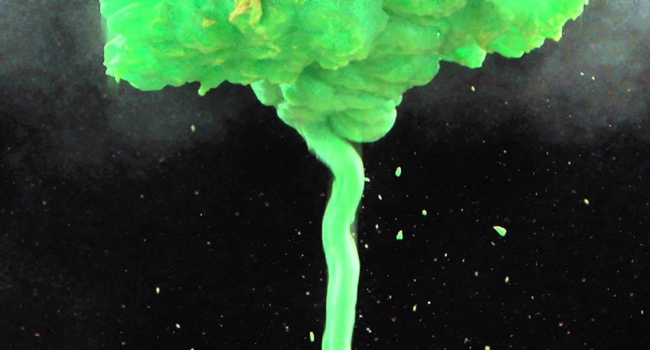60. MGMT – Orcaular Specacular (2008):
 MGMT started as a project to annoy dorm mates next door by mixing the most annoying dance songs together and blasting them all night. At the end of their college career, these New York art school kids turned in their thesis project of “indie-dance music” and didn’t know how muchit would impact their lives. The songs on Oracular Spectacular are about growing up. “Time to Pretend” is about imagining being rock stars; little did MGMT know they wouldn’t have to pretend much longer. “Kids” is easily one of the most recognizable melodies in contemporary music. What separates Oracular Spectacular is that there isn’t one flat track. Every song is polished and fully developed. Most songs on the album could have been a single if they marketed it that way, mixing classic rock, dance-synth, and psychedelic Oracular Spectacular is an album like no other that can’t be copied. –Ian Dick Jones
MGMT started as a project to annoy dorm mates next door by mixing the most annoying dance songs together and blasting them all night. At the end of their college career, these New York art school kids turned in their thesis project of “indie-dance music” and didn’t know how muchit would impact their lives. The songs on Oracular Spectacular are about growing up. “Time to Pretend” is about imagining being rock stars; little did MGMT know they wouldn’t have to pretend much longer. “Kids” is easily one of the most recognizable melodies in contemporary music. What separates Oracular Spectacular is that there isn’t one flat track. Every song is polished and fully developed. Most songs on the album could have been a single if they marketed it that way, mixing classic rock, dance-synth, and psychedelic Oracular Spectacular is an album like no other that can’t be copied. –Ian Dick Jones
59. Death Cab for Cutie – Plans (2005):
 “Sorrow drips into your heart through a pinhole, just like a faucet that leaks, and there is comfort in the sound. But while you debate half-empty or half-full, It slowly rises: your love is gonna drown.” So goes the chorus of the first song on Death Cab for Cutie’s major label debut, Plans. Benjamin Gibbard’s inventive narratives were always a winning component of the Bellingham, WA quartet’s approach, but on Plans, the melodies, hooks and lush production finally gave the band what it needed, and they produced a classic that would solidify their massive popularity. After the success of the first single, the philosophical “Soul Meets Body,” the “hits” just kept on coming, and there’s not a bad cut here. Most notable are the radio staple “Crooked Teeth” and the spare “I Will Follow You Into The Dark.” The latter, with just Gibbard’s acoustic guitar and vocals, became the group’s “Yesterday,” evoking tears from young and old listeners alike. –Craig Bechtel
“Sorrow drips into your heart through a pinhole, just like a faucet that leaks, and there is comfort in the sound. But while you debate half-empty or half-full, It slowly rises: your love is gonna drown.” So goes the chorus of the first song on Death Cab for Cutie’s major label debut, Plans. Benjamin Gibbard’s inventive narratives were always a winning component of the Bellingham, WA quartet’s approach, but on Plans, the melodies, hooks and lush production finally gave the band what it needed, and they produced a classic that would solidify their massive popularity. After the success of the first single, the philosophical “Soul Meets Body,” the “hits” just kept on coming, and there’s not a bad cut here. Most notable are the radio staple “Crooked Teeth” and the spare “I Will Follow You Into The Dark.” The latter, with just Gibbard’s acoustic guitar and vocals, became the group’s “Yesterday,” evoking tears from young and old listeners alike. –Craig Bechtel
58. The White Stripes – White Blood Cells (2001):
 The White Stripes’ third and final independently-released album perfected their simplistic sound into the bluesy, folksy, who-knows-whatsy conglomeration that would change garage rock forever. Meg White’s now famously childlike drumming was the perfect companion to “brother” Jack’s raw vocals and heavy guitar, proving that rock was never about embellishment, but about soul. Tracks on the album combine the best of a wide range of genres, including children’s songs (see: “We’re Going to be Friends”), while the album’s standout single, “Fell In Love With a Girl,” rocks hard in less than two minutes, revealing the Whites’ simple yet ingenious take on straight-up rock n’ roll. –Leanne Howard
The White Stripes’ third and final independently-released album perfected their simplistic sound into the bluesy, folksy, who-knows-whatsy conglomeration that would change garage rock forever. Meg White’s now famously childlike drumming was the perfect companion to “brother” Jack’s raw vocals and heavy guitar, proving that rock was never about embellishment, but about soul. Tracks on the album combine the best of a wide range of genres, including children’s songs (see: “We’re Going to be Friends”), while the album’s standout single, “Fell In Love With a Girl,” rocks hard in less than two minutes, revealing the Whites’ simple yet ingenious take on straight-up rock n’ roll. –Leanne Howard
57. Green Day – American Idiot (2004):
 Had they all graduated from high school, the trio Green Day would have been voted least likely to release a concept album. Like many of their punk forebears, most notably The Ramones and The Buzzcocks, Green Day had always been a singles band. Their sixth record Warning, released in 2000, was no exception, and the band seemed to be experiencing the law of diminishing returns, commercially, critically and artistically. Once they released a greatest hits compilation in 2001 and a B-sides collection in 2002, many wondered how they would go on, and why. But this “punk rock musical,” inspired in part by “West Side Story” and fueled by the apathy, ennui and rage of living in America under W./Cheney rule, is their best record overall. Given the ambitious concept, it’s amazing how well it’s executed, and how solid the songs are throughout. For once, a number one debut was justified. –Craig Bechtel
Had they all graduated from high school, the trio Green Day would have been voted least likely to release a concept album. Like many of their punk forebears, most notably The Ramones and The Buzzcocks, Green Day had always been a singles band. Their sixth record Warning, released in 2000, was no exception, and the band seemed to be experiencing the law of diminishing returns, commercially, critically and artistically. Once they released a greatest hits compilation in 2001 and a B-sides collection in 2002, many wondered how they would go on, and why. But this “punk rock musical,” inspired in part by “West Side Story” and fueled by the apathy, ennui and rage of living in America under W./Cheney rule, is their best record overall. Given the ambitious concept, it’s amazing how well it’s executed, and how solid the songs are throughout. For once, a number one debut was justified. –Craig Bechtel
56. Brand New – Deja Entendu (2003):
 No band in recent memory made such a gigantic leap from their freshman album to their sophomore effort than the Jesse Lacey-fronted quintet Brand New. Deja Entendu is the seminal album for a lot of kids who progressed from the punk/emo scene to a more sophisticated musical palate. Lacey’s poetic angst taught a generation of kids how to express emotions and heart ache while being backed by the perfect soundscape for those feelings. Driving hits like “Good To Know That If I Ever Need Attention All I Have to Do Is Die” and “The Quiet Things That No One Ever Knows” ignited adrenaline and were contrasted beautifully by ballads like “Play Crack The Sky” combining to make a beautifully perfect piece of Americana. –Matt Wink
No band in recent memory made such a gigantic leap from their freshman album to their sophomore effort than the Jesse Lacey-fronted quintet Brand New. Deja Entendu is the seminal album for a lot of kids who progressed from the punk/emo scene to a more sophisticated musical palate. Lacey’s poetic angst taught a generation of kids how to express emotions and heart ache while being backed by the perfect soundscape for those feelings. Driving hits like “Good To Know That If I Ever Need Attention All I Have to Do Is Die” and “The Quiet Things That No One Ever Knows” ignited adrenaline and were contrasted beautifully by ballads like “Play Crack The Sky” combining to make a beautifully perfect piece of Americana. –Matt Wink
55. OutKast – Stankonia (2000):
 In the year 2000 OutKast temporarily left their home of Atlanta to travel to the center of the Earth. At the epicenter of the planet exists a place called Stankonia, from which all funky things come. Building off of the artistic progression they showed on Aquemini, Big Boi and André 3000 put together a funk-filled journey involving baby mama drama (“Mrs. Jackson”), laid back tales of being cooler than anyone else (“So Fresh, So Clean”), tongue-twisting political undertones (“B.O.B.”) and even cautionary insight for when a girl is trying squeeze out every bit of Cheesecake Factory from a date that she can (“We Luv Deez Hoez”). Perhaps the greatest rap duo of all time, and Atlanta’s best contribution to the game ever, hit their 4th, and possibly most impressive, home run by changing the way rap is viewed, yet again. –Matt Wink
In the year 2000 OutKast temporarily left their home of Atlanta to travel to the center of the Earth. At the epicenter of the planet exists a place called Stankonia, from which all funky things come. Building off of the artistic progression they showed on Aquemini, Big Boi and André 3000 put together a funk-filled journey involving baby mama drama (“Mrs. Jackson”), laid back tales of being cooler than anyone else (“So Fresh, So Clean”), tongue-twisting political undertones (“B.O.B.”) and even cautionary insight for when a girl is trying squeeze out every bit of Cheesecake Factory from a date that she can (“We Luv Deez Hoez”). Perhaps the greatest rap duo of all time, and Atlanta’s best contribution to the game ever, hit their 4th, and possibly most impressive, home run by changing the way rap is viewed, yet again. –Matt Wink
54. Alkaline Trio – Goddamnit (1998):
 By the late-‘90s, emo had come a long way since its birth in the basements of Washington D.C. The genre had grown to encapsulate everything from the noodly American Football to the abrasive Orchid, and most everything in between. It was in the midst of this that Alkaline Trio released Goddamnit. Building upon Jawbreaker’s foundation, the group constructed its own version on the pop-emo blueprint. Matt Skiba’s voice shakes with defeat as he blasts through up-tempo numbers, while co-vocalist Dan Andriano tries to croon his way out of depression. Each song personifies the trio’s heat-on-sleeve lyricism, tighly wound melodies, and fondness for the dark side. The record’s ragged production only highlights the strengths and desperation of the young, brooding power-trio. –David Anthony
By the late-‘90s, emo had come a long way since its birth in the basements of Washington D.C. The genre had grown to encapsulate everything from the noodly American Football to the abrasive Orchid, and most everything in between. It was in the midst of this that Alkaline Trio released Goddamnit. Building upon Jawbreaker’s foundation, the group constructed its own version on the pop-emo blueprint. Matt Skiba’s voice shakes with defeat as he blasts through up-tempo numbers, while co-vocalist Dan Andriano tries to croon his way out of depression. Each song personifies the trio’s heat-on-sleeve lyricism, tighly wound melodies, and fondness for the dark side. The record’s ragged production only highlights the strengths and desperation of the young, brooding power-trio. –David Anthony
53. Madvillain – Madvillainy (2004):
 MF Doom and Madlib turned the hip-hop world on its head with their collaborative effort, Madvillainy. The album revolves around the alter egos of the duo, creating a sort of cartoonish villain theme underlying the varied lyrical topics. Sometimes abstract, sometimes concrete, Doom’s flow and writing style is so unique that even when he’s tackling common themes it comes out a perfectly original thought (who else would reference Bel Biv DeVoe in an emotionally charged song about being cheated on?). And for all of Madlib’s unconventional beat work (check the excellent accordion loop on “Accordion” or the Gentle Giant sampling in “Strange Ways”), Doom always seems completely comfortable. The tracks are mostly two-minute bursts so no ideas are run into the ground, but they will constantly have listeners hitting the back button. –Chris Favata
MF Doom and Madlib turned the hip-hop world on its head with their collaborative effort, Madvillainy. The album revolves around the alter egos of the duo, creating a sort of cartoonish villain theme underlying the varied lyrical topics. Sometimes abstract, sometimes concrete, Doom’s flow and writing style is so unique that even when he’s tackling common themes it comes out a perfectly original thought (who else would reference Bel Biv DeVoe in an emotionally charged song about being cheated on?). And for all of Madlib’s unconventional beat work (check the excellent accordion loop on “Accordion” or the Gentle Giant sampling in “Strange Ways”), Doom always seems completely comfortable. The tracks are mostly two-minute bursts so no ideas are run into the ground, but they will constantly have listeners hitting the back button. –Chris Favata
52. Interpol – Turn on the Bright Lights (2002):
 Interpol could easily have been lumped in with other post-punk revivalists of the early aughts—such as Bloc Party and The Strokes, but the murky guitar and treacherous drums on Turn On the Bright Lights wouldn’t allow it. The godsons of Joy Division rolled out a stunning debut with gloomy lyrics (“Stella Was a Diver and She was Always Down”), lackadaisical adrenaline (“Obstacle 1”) and a gritty attitude seasoned on the streets of New York (“Say Hello to the Angels”), and innovated their own idea of the genre with sometimes danceable bass lines (“Roland”) and hookier-than-fishing-line bridges (“PDA”). –Ciara Shook
Interpol could easily have been lumped in with other post-punk revivalists of the early aughts—such as Bloc Party and The Strokes, but the murky guitar and treacherous drums on Turn On the Bright Lights wouldn’t allow it. The godsons of Joy Division rolled out a stunning debut with gloomy lyrics (“Stella Was a Diver and She was Always Down”), lackadaisical adrenaline (“Obstacle 1”) and a gritty attitude seasoned on the streets of New York (“Say Hello to the Angels”), and innovated their own idea of the genre with sometimes danceable bass lines (“Roland”) and hookier-than-fishing-line bridges (“PDA”). –Ciara Shook
51. LCD Soundsystem – LCD Soundsystem (2005):
 James Murphy’s debut under his widely renowned LCD Soundsystem moniker was the beginning of a dance-punk revolution. Murphy fearlessly explored his inner music geek while maintaining a focus on physicality over songwriting. Hence, a record’s ability to withstand generational fluctuations deemed itself more important, in Murphy’s opinion, than its pertinence to a specific era. And this approach persevered throughout Murphy’s career. Though LCD Soundsystem’s output seems rather short-lived, the group’s initial self-titled double disc included an album and subsequent collection of re-released singles. As a whole then, LCD Soundsytem is greater its separate parts, even if its relevance is situated on the dance floor in the hands of DJ nerds. –Jenn Beening
James Murphy’s debut under his widely renowned LCD Soundsystem moniker was the beginning of a dance-punk revolution. Murphy fearlessly explored his inner music geek while maintaining a focus on physicality over songwriting. Hence, a record’s ability to withstand generational fluctuations deemed itself more important, in Murphy’s opinion, than its pertinence to a specific era. And this approach persevered throughout Murphy’s career. Though LCD Soundsystem’s output seems rather short-lived, the group’s initial self-titled double disc included an album and subsequent collection of re-released singles. As a whole then, LCD Soundsytem is greater its separate parts, even if its relevance is situated on the dance floor in the hands of DJ nerds. –Jenn Beening



